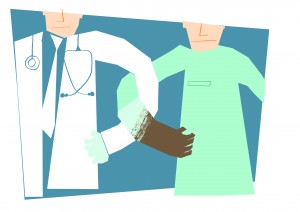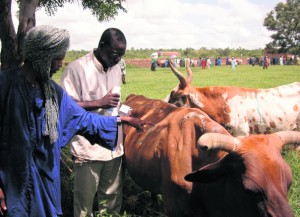WEDNESDAY, 18 JANUARY 2012
Stepping into the yurt, the odour of mutton flesh and skin is overwhelming and the smoky fire does little to dull your senses. In the corner lies Ganzorig, his wife Goyo tending to his undulating fever while their children sit nearby, watching their father writhe in pain. The fever is not fatal, but it can last for many months and is exacerbated by incessant arthritic and muscular pain. Ganzorig is suffering from brucellosis, a bacterial disease that has become a growing problem in Mongolia, but one which the world seems unmotivated to eradicate or even control.Brucellosis is a zoonotic disease—one that can be transmitted from animals to humans (and occasionally vice versa). Over 60 per cent of the pathogens that are infective to humans are zoonotic. The World Health Organisation (WHO) has classified brucellosis as a ‘Neglected Zoonotic Disease’ (NZD).
What makes a disease ‘neglected’? There are many factors but a general rule-of-thumb is that their impact appears, to most, to be insignificant. But with 40 per cent of the world’s poor dependent upon making a living from agriculture and at risk from zoonotic infections, can we afford to continue the neglect and hope that these diseases will eventually disappear?
A 2006 WHO report suggests that because NZDs cross the boundary of human and animal medicine, we struggle to compartmentalise them, with neither side accepting responsibility. As a result, countries which already have poor medical infrastructure further marginalise the disease burden. Poor communication between the veterinary and medical communities leads to no real appreciation of the impact and consequently there are no programmes for control. The result is a neglected disease that continues to spiral out of control.
Jim Scudamore, of the Integrated Control of Neglected Zoonosis (ICONZ), suggests that as well as having no real knowledge of disease incidence (the occurrence over time), there is no information on the costs to animal production or human health, nor any indication of the most successful methods of control. Jim is a veterinary surgeon specialising in Veterinary Public Health—the application of veterinary science to ensure the health and wellbeing of humans—and believes that vets have a broad range of expertise to deal with the animal side of the NZD equation, but cannot solve it on their own.
In the ICONZ project he assesses the incidence of disease before intervention, then an intervention to control it, followed by measurements to see the outcome. From the results, ICONZ will prepare policy papers on costs and benefits and attempt to persuade policy makers to take action. So are we missing a key member of the team? Is there an unseen player that could make a real and lasting difference? Perhaps veterinary surgeons are the missing piece in International Development.
By treating animals, can we truly treat people? Ganzorig is likely to have been infected from one of the small flock of sheep that he farms to supply his family with meat and wool, and which in hard times can be sold to keep the family above the poverty line. Brucellosis was almost eradicated from Mongolian animals in the 1980s, but following political turmoil with the Soviet Union in the 1990s, has reared its ugly face once more. If the WHO had been able to continue vaccinating animals under Soviet rule, perhaps Mongolian livestock and wildlife would be disease-free.
WHO see the control of neglected diseases as a real and cost-effective opportunity for alleviating poverty and include it in the plan to achieve Millennium Development Goal 6—eradication of disease. Why, then, don’t aid-donating countries, such as the UK, focus on programmes linked to NZD control? A call to Dr Alex Thiermann from the World Organisation for Animal Health (which goes by its French acronym OIE) sheds some light. “Many of these diseases have been eradicated in the developed world and there appears little incentive for us to help control them elsewhere, yet they continue to be a major issue. Vets can play a role in communicating the importance of NZDs to the world and also in helping design, implement and assess control programmes.’’
Now that the veterinary profession is over 250 years old, having begun with the world’s first vet school in Lyon, we should look to vets to help build the infrastructure and programmes needed to alleviate rural poverty. The days of James Herriot style vetting have gone and the world has changed; vets can now play a key role in helping humans as well as animals. When I tell people I am a veterinary student their reaction is invariably that it must be hard to treat an animal if it can not tell you where it hurts. This is when the most important principle of veterinary medicine comes into play: communication. If we can liaise with our clients and get a good history leading up to the illness, we can get a rough diagnosis. “Vets aren’t the pioneers of good communication!” continues Thiermann, “OIE are developing a project with the One Health concept to illustrate the multifaceted work of veterinarians called ‘Vets in Daily Life’.”
One Health aims to bring together the disciplines of human and veterinary medicine with environmental science. It appreciates the interface between people and animals (both domestic and wild) and the need to look at all three areas to create one plan that will help both people and animals.
In common with any development package, money is a necessity. Aid agencies need to look afresh at where they target their resources and determine whether NZD control really can provide a cost-effective and lasting means towards alleviating poverty. Initially a legal and political framework needs to be implemented, followed by infrastructure and finally, programme delivery. But few, apart from a small section of WHO and independent NGOs, have set NZDs as a priority. These diseases are not ‘sexy’; the epidemiology is complex involving people, wildlife and domestic animals all at one interface. Their devastating consequences are not easy to solve and they are killers of animals, people and communities. We must first identify the communities suffering from these hidden diseases and provide effective treatment. Motivation for action must come from inside the medical and veterinary world. Only by working together in a consistent manner will we ensure that Ganzorig’s children will not face the same fate as their father.
Peter Moore is a 5th year student in the Department of Veterinary Medicine



